Homework/Exam Format Requirements and Guidelines
It is very difficult to read work which does not follow minimum standards of format. Consequently, a large portion of your homework/exam grades will be based on presentation. The following procedures must be followed in order to receive full credit on any problem you turn in. Click on each link for details.
- State the Problem.
- If Two Things are Equal, Write =.
- If Two Things are Not Equal, Do Not Write =.
- Write in English.
- Label EVERYTHING.
1. State the Problem. (not necessary on tests)
Just having the goal of the problem in front of you can help you get started on many problems. The first thing you must write (after the number of the problem) is a statement that you can understand about what you are being asked to do. You do not have to copy the problem's instructions verbatim; on the contrary, I would like to see the directions in your own words. Never begin a solution with a formula.
Example. A 10-foot ladder is leaning against a wall. The bottom of the ladder is 1 ft. from the wall. At what height above the ground is the top of the ladder touching the wall?
| |
| |
Good beginnings of solution |
What's good |
| 1. |
 |
Statement is in student's own words, contains a verb ("find") saying what the goal of the problem is |
| 2. |
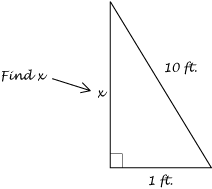 |
Instructions are clearly indicated on the picture |
|
|
| |
| |
Unacceptable beginnings of solution |
What's bad |
| 1. |
 |
No verb saying what the goal of the problem is |
| 2. |
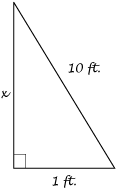 |
No instructions or goals appear on the picture |
| 3. |
 |
No instructions or goals, just a mysterious formula |
|
Back to Top
2. If two things are equal, write =.
Sounds simple, right? It is essential to specify exactly what the relationships are between statements such as 3x and 2y + 5 (is it =? Less than? Greater than or equal to?). If you are simplifying an expression, for example, you must write each step below the previous one and write "=" to the left of each one to show that it is equal to the expression on the line above it.
Example. Simplify 2x - 3 + x + 4x².
| |
| |
Good solution |
What's good |
| |
 |
Student states the goal of the problem
Notice the equal signs connecting each line |
|
|
| |
| |
Unacceptable solutions |
What's bad |
| 1. |
 |
No equal signs, just a series of expressions |
| 2. |
 |
Solution begins with an equal sign--this is the mathematical equivalent of beginning a sentence with no subject, e.g. "Went to the store." Who went? What is equal to 4x²+ 2x + x - 3 ? |
|
Back to Top
3. If two things are not equal, do not write =.
In other words, do not write anything that is untrue. Believe me, I have seen way too many papers that violate this rule. It's surprisingly easy to do, so check your papers carefully.
Example. Simplify  .
.
| |
| |
Good solution |
What's good |
| |
 |
Student states the goal of the problem
Appropriate use of equal signs: all expressions are indeed equal |
|
|
| |
| |
Unacceptable solution |
What's bad |
| |
 |
Inappropriate use of equal signs: note that  ! What do you think the student was trying to say here? ! What do you think the student was trying to say here? |
|
Back to Top
4. Write in English.
This sounds funny, but I have read many incomprehensible papers that just have a bunch of math-like gibberish on them. It is so easy to "get lost" and write incomplete mathematical "sentences." The best way to avoid errors and learn the material correctly is to make sure you can read your work out loud and have it make sense. Pretend you are teaching the material to the grader. Remember, the grader can't read your mind. You must make the effort to be clear.
Please note that on any homework problem, you must justify your answers even if the problem does not specifically ask you to do so. "I did it in my head" is not considered justification!
Example. Solve the following inequality for x: 3xy - 4x > 2 + x.
| |
| |
Good solution |
What's good |
| |
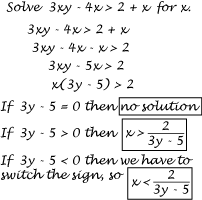 |
Student states the goal of the problem
Each line states the next step completely
Student explains the different answers |
|
|
| |
| |
Unacceptable solution |
What's bad |
| |
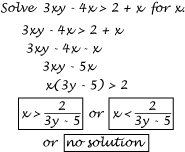 |
These lines have lost the >; the statements are incomplete
Ambiguous answers with no explanation |
|
Back to Top
5. Label EVERYTHING.
You must explain what you are doing in each part of a multiple-part problem. If you do problems out of order, write a note or draw arrows explaining where to find the problems. Do not cram problems together. The grader has the authority to take off points if he/she
- Cannot find a problem
- Cannot read your handwriting, or
- Cannot follow your reasoning.
For more complicated problems you should consider working them out first on scratch paper, then recopying the finished solution to turn in. In the case of proofs, it is almost inevitable that you will do so. In any case, please make it easy for the grader to evaluate your work.
Example. A woman starts at a point A. She walks due east for 300m and then due north for 400m, ending at B. Sketch her path, and sketch the shortest path between A and B. What is the shortest distance from A to B?
| |
| |
Good solution |
What's good |
| |
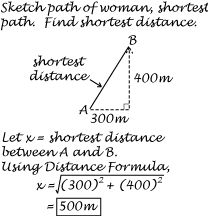 |
Student states all the goals of the problem
Picture is fully labeled
Student identifies what x means
Student identifies the formula he/she is using
Answer has appropriate units |
|
|
| |
| |
Unacceptable solution |
What's bad |
| |
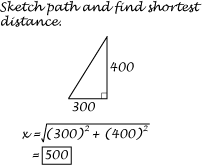 |
Not all parts of the problem are stated
Picture is not complete: points A and B are not labeled, the shortest distance is not indicated, and the units are not stated (i.e. 300 what?)
No explanation of what x means or what formula student is using
Answer is expressed without appropriate units |
|
Back to Top
If all of the above seems terribly pedantic--it is. But good mathematical form is not only more beautiful and easier for the grader to read (always a plus for your grade!), but it becomes more and more crucial for avoiding errors as the topics get more difficult. You may always feel free to ask me about the presentation of any problem if you're not sure.
Special note for Math 152 Students. Proof-writing is a difficult skill to master; you will undoubtedly encounter some frustration this term as you try to express yourself logically. Please be patient with yourself and with me as you master this paramount skill.